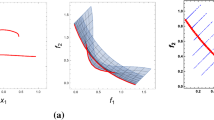Abstract
In this paper we address the question of how many objective functions are needed to decide whether a given point is a Pareto optimal solution for a multicriteria optimization problem. We extend earlier results showing that the set of weakly Pareto optimal points is the union of Pareto optimal sets of subproblems and show their limitations. We prove that for strictly quasi-convex problems in two variables Pareto optimality can be decided by consideration of at most three objectives at a time. Our results are based on a geometric characterization of Pareto, strict Pareto, and weak Pareto solutions and Helly's Theorem. We also show that a generalization to quasi-convex objectives is not possible and state a weaker result for this case. Furthermore, we show that an analogous result for deciding strict Pareto optimality is impossible, even in the convex case.
Similar content being viewed by others
Author information
Authors and Affiliations
Additional information
Manuscript received: October 2001/Final version received: January 2002
Rights and permissions
About this article
Cite this article
Ehrgott, M., Nickel, S. On the number of criteria needed to decide Pareto optimality. Mathematical Methods of OR 55, 329–345 (2002). https://doi.org/10.1007/s001860200207
Published:
Issue Date:
DOI: https://doi.org/10.1007/s001860200207




